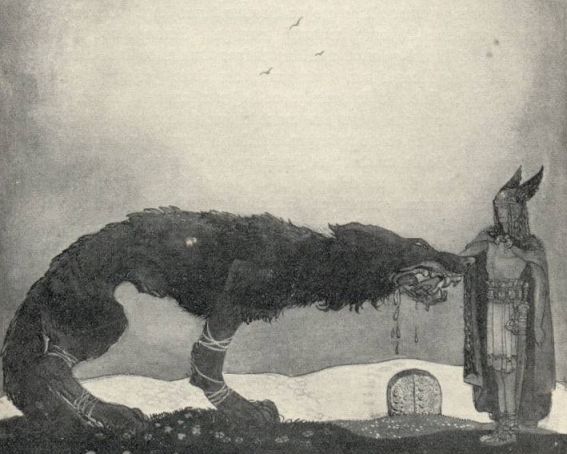January Lesson
This month we will read about the Fenrir wolf, one of the monsters of Norse Mythology.
The Fenrir wolf is bound
The Fenrir wolf was the son of Loki and the giantess Angrboda. Because of his giant ancestry he quickly grew very large and very strong. The gods had let him stay in Asgard, but when he grew stronger they feared he would overpower them. And when they heard a prophecy that Fenrir would cause great harm to the gods during Ragnarok, they decided they had to get rid of him – without killing him, because he was their guest and it was forbidden to kill guests.
The best way to make Fenrir less harmful would be to bind him well, they thought. So they created a very strong heavy chain called Loeding and asked Fenrir to try and break it. Fenrir didn’t think it looked very strong so he let them bind him with it, and as soon as he stretched his body Loeding snapped.
The gods went on to create a chain twice as strong as Loeding, and they called it Drome. They asked Fenrir to try and break Drome, and Fenrir allowed them to bind him. He stretched his body and shook it vigorously, and the chain broke into many pieces.
Odin sent Frey’s envoy Skirnir to the dwarves, and the dwarves forged the strongest chain ever seen – but it looked like a thin rope. They called it Gleipnir, and it was forged from the rumble of a cat’s steps, women beards, the roots of mountains, bear sinews, the breath of fish and bird’s saliva. (The reason you’ll never find any of these things in the world today is the dwarves used it all up when they created Gleipnir.)
When the gods got Gleipnir they travelled to the islet Lyngvi in the lake Amsvartnir and asked Fenrir to come there. They showed him the thin rope Gleipnir, showed him that none of them could break it, and asked him if he could try. Fenrir was suspicious because Gleipnir looked so weak, so he thought that maybe they were trying to trick him. But he didn’t want to be called a coward, so he let them bind him – on the condition that one of the gods held his hand in Fenrir’s mouth while he was bound, just in case they tricked him.
The gods looked at each other, and knew that one of them had to lose his hand – they were tricking Fenrir after all – but they thought that the prize was rather high and no one was very willing to make that sacrifice. But then Tyr, braver than most gods, stepped forward and offered his right hand.
Fenrir was bound, but when he tried to break free Gleipnir only bound him even tighter. Fenrir realized this was a trap, and bit off Tyr’s hand in revenge. The gods fastened the ends of Gleipnir in the ground with two huge rocks, and Fenrir will stay bound like this until Ragnarok, when he will be released and get his revenge on the gods.

Sources:
Stora boken om vikingarnas gudar och myter by Lars Magnar Enoksen (ISBN 978-91-7738-792-3)